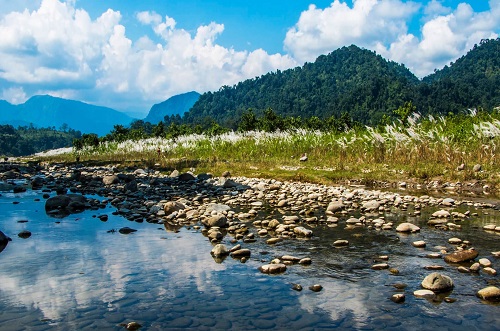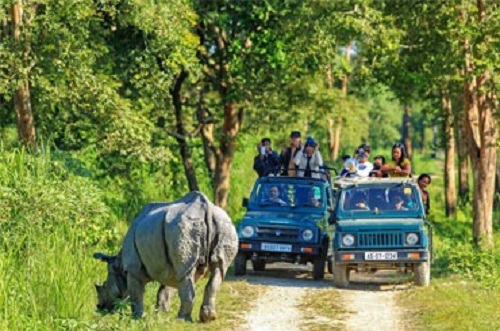
Assam Tourism
Assam is truly a paradise for nature lovers and wildlife enthusiasts, boasting an incredible diversity of flora and fauna. The state is home to 5 National Parks, 17 Wildlife Sanctuaries, and 3 Bird Sanctuaries, making it one of the most sought-after destinations for eco-tourism and wildlife experiences in India. Here’s a breakdown of some of the key parks and sanctuaries that make Assam a haven for nature enthusiasts.
National Parks in Assam
Assam’s National Parks are renowned worldwide for their rich biodiversity, especially for housing several endangered species. Let’s explore the top 5
Kaziranga National Park
- Famous for: One-horned rhinoceros, Bengal tigers, elephants, and bird watching.
- UNESCO World Heritage Site.
- Best Time to Visit: November to April.
Manas
- Famous for: Bengal tigers, wild water buffalo, pygmy hog, and golden langur.
- UNESCO Natural World Heritage Site.
- Best Time to Visit: October to April.
Dibru-Saikhowa National Park
- Famous for: Wild horses (feral), river dolphins, and rich birdlife.
- Known for its semi-evergreen forests and wetlands, it’s a paradise for bird watchers.
- Best Time to Visit: November to April.
Nameri National Park
- Famous for: Elephants, tigers, leopards, and more than 300 bird species.
- Ideal for wildlife safaris, trekking, and bird-watching.
- Best Time to Visit: November to April.
Orang National Park
- Famous for: One-horned rhinoceros, Bengal tigers, and migratory birds.
- Often referred to as the “Mini Kaziranga” because of its similar ecosystem.
- Best Time to Visit: November to April.
Wildlife Sanctuaries in Assam
Assam’s 17 Wildlife Sanctuaries are home to a variety of ecosystems, from dense forests to wetlands, providing habitats to some of India’s most exotic species.
Pobitora Wildlife Sanctuary
- Famous for: The highest density of one-horned rhinoceroses.
- Best Time to Visit: November to March.
Hoollongapar Gibbon Sanctuary
- Famous for: India’s only ape species, the Hoolock gibbon.
- Dense forests, are also home to a variety of primates.
- Best Time to Visit: October to April.
Sonai Rupai Wildlife Sanctuary
- Famous for: Indian elephants, Bengal tigers, and several species of birds.
- Nestled at the foothills of the Himalayas.
- Best Time to Visit: November to April.
etc..
Chakrashila Wildlife Sanctuary
- Famous for: The rare golden langur and rich biodiversity.
- A paradise for wildlife photographers and nature lovers.
- Best Time to Visit: October to April.
Bura-Chapori Wildlife Sanctuary
- Famous for: Bengal tigers, rhinoceroses, and migratory birds.
- Located along the Brahmaputra River, making it a popular destination for river safaris.
- Best Time to Visit: November to April.
Bird Sanctuaries in Assam
Assam’s 3 Bird Sanctuaries offer spectacular opportunities for bird watching, making it a must-visit for ornithologists and bird enthusiasts.
Deepor Beel Bird Sanctuary
- Famous for: Migratory birds like Siberian cranes, and greater adjutants.
- A Ramsar site and one of the largest freshwater lakes in Assam.
- Best Time to Visit: October to March.
Bordoibam Beelmukh Bird Sanctuary
- Famous for: A diverse variety of birds, including storks, herons, and ducks.
- Best for eco-tourism and bird photography.
- Best Time to Visit: October to April.
Panidihing Bird Sanctuary
- Famous for: Large congregations of migratory birds, particularly waterfowl.
- Ideal for spotting species like the bar-headed goose and pelicans.
- Best Time to Visit: November to March.
Explore Assam Tourism: Top Tours and Travel Experiences
Top Religious Destinations: Pilgrimage Sites for Faith and Reflection
Assam, a culturally rich state in northeastern India, is not only known for its breathtaking landscapes and diverse wildlife but also its spiritual heritage. The state is home to numerous religious destinations that attract pilgrims and spiritual seekers from around the country and beyond. Here are some of the top religious destinations in Assam that offer a serene environment for faith and reflection:
Kamakhya Temple: Located on the Nilachal Hills in Guwahati, the Kamakhya Temple is one of the oldest and most revered Shakti Peethas in India. Dedicated to the goddess Kamakhya, this temple is known for its unique practices and annual Ambubachi Mela, which celebrates the goddess’s fertility. The temple’s stunning architecture and spiritual ambience make it a must-visit for anyone seeking a deeper connection with the divine.
Gurdwara Sri Guru Tegh Bahadur Sahib: This is the Gurdwara of Sikhs in Dhuburi town on the bank of the Brahmaputra River in Assam, India. The first Sikh guru, Guru Nanak Dev, visited this place in 1505 AD and the 9th Guru Teg Bahadur came to this place and established this Gurdwara during the 17th century.
Hajo: Hajo is a significant pilgrimage site for Hindus, Buddhists, and Muslims alike. The Kali Mandir, dedicated to Goddess Kali, is situated on the Hajo hilltop, offering panoramic views of the surrounding landscape. The temple holds immense religious significance and attracts visitors from various faiths, fostering a spirit of unity and peace.
Umananda Temple: Situated on Peacock Island in the Brahmaputra River, Umananda Temple is dedicated to Lord Shiva. The temple, built in the 17th century, is surrounded by lush greenery and offers a tranquil setting for meditation and reflection. The picturesque boat ride to the island enhances the spiritual experience, making it a popular destination for both locals and tourists.
Baba Bakala Temple: Located in the Karbi Anglong district, Baba Bakala Temple is a revered shrine dedicated to the Hindu saint Baba Bakala. Surrounded by hills and lush greenery, the temple attracts devotees seeking blessings and spiritual solace. The peaceful atmosphere and stunning views make it a perfect spot for reflection and prayer.
Heritage And Traditions
Assam, located in northeastern India, is renowned for its rich heritage and diverse cultural landscape. With a history that dates back to ancient times, the region has been shaped by various kingdoms, including the Kamarupa Kingdom and the Ahom Dynasty, which ruled for six centuries and promoted agricultural and trade prosperity.
Festivals
Festivals are a vibrant expression of Assamese culture, with Bihu being the most significant, celebrated three times a year to mark the agricultural calendar. Other important festivals include Durga Puja and Rath Yatra, showcasing traditional music, dance, and communal activities.
Art and Craft
Assam is famous for its handwoven Muga silk, pottery, bamboo crafts, and intricate wood carvings. Sattriya is a classical dance form, while folk dances like Bihu dance highlight the region’s artistic expressions.
Cuisine
Assamese cuisine is characterised by its simplicity and freshness, with rice as the staple food. Unique dishes like masor tenga (sour fish curry) and Pitha (rice cakes) reflect the local culinary traditions.
Haritage City of Assam
Sibsagar: Sivasagar, previously known as Rangpur, served as the capital of the Ahom Kingdom from 1699 to 1788. The Ahoms ruled Assam for six centuries, significantly influencing the region’s culture and history until their kingdom fell to the Burmese in 1819, resulting in the near extinction of their ruling class.
Today, Sivasagar is a treasure trove of historical landmarks that reflect its glorious past. Key attractions include:
- Talatal Ghar: A remarkable multi-story palace built by the Ahom kings, known for its unique architecture and historical importance.
- Rang Ghar: The largest amphitheatre in Assam, once used for royal sports and events, showcasing the grandeur of the Ahom era.
- Tai Museum: This museum preserves the culture and history of the Tai people, featuring artifacts and exhibitions that highlight their heritage.
- Charaideo: The historic burial site of Ahom kings, renowned for its beautiful mounds and traditional architecture.
- Joysagar Tank: A significant water tank created by Ahom king Rudra Singha, surrounded by temples and important for local rituals.
- Shivadol: One of the tallest Shiva temples in Assam, celebrated for its exquisite architecture and spiritual significance.
Sivasagar offers a captivating glimpse into Assam’s rich history and is a must-visit destination for those interested in exploring the legacy of the Ahom Kingdom.
Sualkuchi: Sualkuchi is renowned as the heart of the Assamese silk industry. This vibrant town is famous for producing Muga silk, derived from the silkworm Antheraea assamensis, which is native to Assam. The larvae thrive on the leaves of the som (Machilus bombycina) and sualu (Litsea polyantha) trees, which play a crucial role in the silk-making process.
The Muga silk produced here is highly regarded for its lustrous sheen, fine texture, and exceptional durability, making it a prized material in traditional Assamese garments. Sualkuchi not only showcases the craftsmanship of local weavers but also embodies the rich cultural heritage of Assam, with its intricate designs and vibrant colours reflecting the state’s artistic traditions. Visitors to Sualkuchi can witness the intricate weaving process and appreciate the artistry that goes into creating these exquisite silk fabrics.
Jorhat : Jorhat is known as the epicentre of Assam’s tea gardens and industry, celebrated for producing some of the finest teas in the world. The lush green landscapes dotted with sprawling tea estates create a picturesque setting that attracts visitors from near and far.
For a truly immersive experience, travellers can arrange to stay in a tea garden bungalow, allowing them to enjoy the serene beauty of the surroundings while learning about the tea production process. This unique opportunity offers guests a chance to explore the tea gardens, interact with local tea workers, and savour freshly brewed Assam tea, all while soaking in the tranquillity of this enchanting region. Jorhat not only serves as a gateway to the tea industry but also embodies the rich cultural heritage and natural beauty of Assam.
Majuli : Majuli, spanning 352 square kilometres (136 square miles), holds the title of the world’s largest river island. Renowned for its unspoiled beauty, Majuli offers a glimpse into a tranquil rural lifestyle that captivates visitors seeking a serene escape from the hustle and bustle of city life.
The island is characterized by its lush landscapes, vibrant culture, and unique biodiversity, making it a haven for nature lovers and those interested in indigenous traditions. Visitors can explore the island’s traditional villages, witness vibrant festivals, and engage with the local communities that maintain their rich heritage. Majuli’s pristine environment and laid-back atmosphere make it an ideal destination for those looking to experience the charm of rural Assam while enjoying the natural wonders of the Brahmaputra River.
Achievements and Recognitions




Address List
- Sixmile, Panjabari, Guwahati
- +91 94355 15011
- +91 86386 04075
- query.naturehunt@gmail.com

Happiness is traveling



